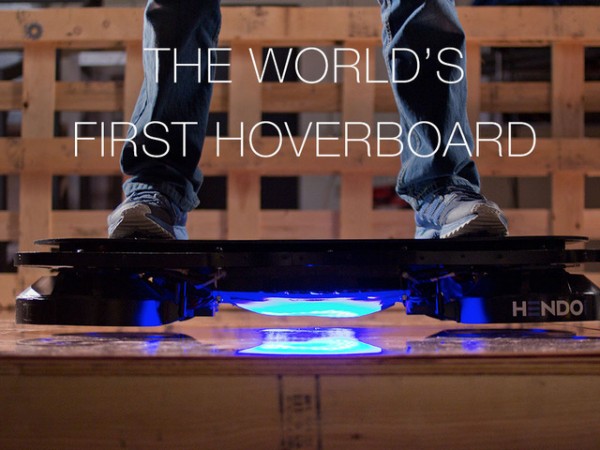California Tech Firm Invents World's First Hoverboard
| Michael A. Katz | | Oct 21, 2014 04:43 PM EDT |
(Photo : Arx Pax) Science fiction has become science fact as a California-based Arx Pax has invented a hovering skateboard, igniting the imagination of kids and adults everywhere.
Science fiction has become science fact as a California-based Arx Pax has invented a hovering skateboard, igniting the imagination of kids and adults everywhere.
The startup, founded by Greg and Jill Henderson, launched a Kickstarter fund-raising campaign for their Hendo Hoverboard. However, users will need two things before they can own and use the flying skateboard - $10,000 and a metal floor.
Like Us on Facebook
Hoverboards were first made famous in the 1989 sci-fi movie "Back to the Future II." Arx Pax is well aware of this fact, but refrains from making references to the film for legal reasons.
"Yep, there was a movie," the company says on its Kickstarter site. "However, our attorneys have told us not to go there."
The Hendo, named after Arx Pax's founders, hovers about 1 inch off the ground. The technology behind the hoverboard lies in its four disc-shaped hover engines. These create a magnetic field that pushes against itself, generating the lift to levitate the board off the ground.
Unfortunately, the Hendo can't be used on any old surface or floor. At the moment, the surface needs to be a non-ferromagnetic conductor. The firm uses commonly available metals in simple sheets, but says it is working on new compounds and new configurations to maximize the technology and minimize costs.
For those who are mechanically inclined, for about $300, Arx Pax will sell its Whitebox Devleoper Kit, which is a Hendo hover engine set. It allows users to remove the engines and try "hovering something of your own design," says the company.
Not surprisingly, the tricky part for the company when creating the hoverboard was figuring out how to use magnets for levitation. Due to Earnshaw's Theorem, a stable static equilibrium between two magnets is not possible.
"There have been several ways around this, but none have proven feasible enough for everyday applications," said the company. "Until now."
According to Arx Pax, Lenz's law explains how eddy currents are created when magnets are moved relative to a conductive material. These eddy currents in turn create an opposing magnetic field in the conductor. The company's core technology, which it calls Magnetic Field Architecture (MFA), focuses this field more efficiently.
But creating hoverboards is not the long-term goal of the Arx Pax. In fact, it is merely an introductory product, a precursor intended for the broader implementation of the MFA.
"It enables a new generation of lift and motion technology that will change the way we view transportation," the company said. "Additional applications for MFA technology are virtually limitless - from business, to industry, to healthcare, and beyond."
Tagsworld's first hoverboard, hoverboard, Arx Pax, Hendo, Kickstarter, invents hoverboard, Back to the Future II, The hoverboard is real, Jill and Greg Henderson, Magnetic Field Architecture, the hoverboard is here
©2015 Chinatopix All rights reserved. Do not reproduce without permission
EDITOR'S PICKS
-

Did the Trump administration just announce plans for a trade war with ‘hostile’ China and Russia?
-

US Senate passes Taiwan travel bill slammed by China
-

As Yan Sihong’s family grieves, here are other Chinese students who went missing abroad. Some have never been found
-

Beijing blasts Western critics who ‘smear China’ with the term sharp power
-

China Envoy Seeks to Defuse Tensions With U.S. as a Trade War Brews
-

Singapore's Deputy PM Provides Bitcoin Vote of Confidence Amid China's Blanket Bans
-

China warns investors over risks in overseas virtual currency trading
-

Chinese government most trustworthy: survey
-

Kashima Antlers On Course For Back-To-Back Titles
MOST POPULAR
LATEST NEWS
Zhou Yongkang: China's Former Security Chief Sentenced to Life in Prison

China's former Chief of the Ministry of Public Security, Zhou Yongkang, has been given a life sentence after he was found guilty of abusing his office, bribery and deliberately ... Full Article
TRENDING STORY

China Pork Prices Expected to Stabilize As The Supplies Recover

Elephone P9000 Smartphone is now on Sale on Amazon India

There's a Big Chance Cliffhangers Won't Still Be Resolved When Grey's Anatomy Season 13 Returns

Supreme Court Ruled on Samsung vs Apple Dispute for Patent Infringement

Microsoft Surface Pro 5 Rumors and Release Date: What is the Latest?










